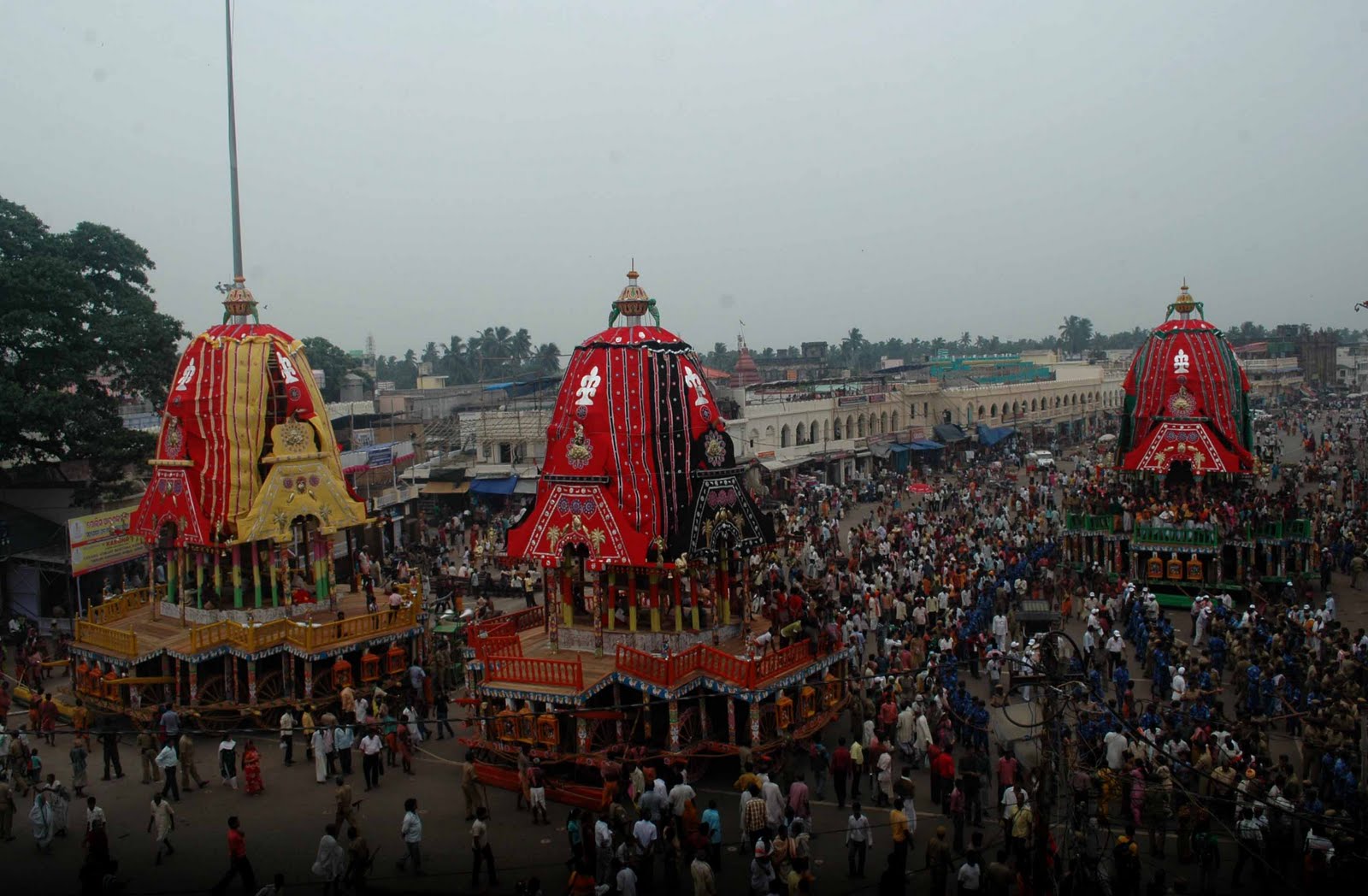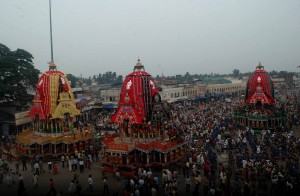 The Puri Rath Yatra is world famous for the crowd that it attracts. Puri being the abode of these three deities, the place plays host to devotees, tourists and about one million pilgrims from acrossIndia and abroad. Many artists and artisans are engaged in building these three chariots, weaving its fabric covers that dress up the chariots, and painting them in the right shades and motifs to give them the best possible looks.Fourteen tailors are engaged in stitching up the covers that require almost 1,200 meters of cloth.
The Puri Rath Yatra is world famous for the crowd that it attracts. Puri being the abode of these three deities, the place plays host to devotees, tourists and about one million pilgrims from acrossIndia and abroad. Many artists and artisans are engaged in building these three chariots, weaving its fabric covers that dress up the chariots, and painting them in the right shades and motifs to give them the best possible looks.Fourteen tailors are engaged in stitching up the covers that require almost 1,200 meters of cloth.
History Rath Yatra of Jagannath Puri
The temple was originally built by the Kalinga ruler Anantavarman Chodaganga (1078 – 1148 CE). Much of the present structure was built by King Ananga Bhima Deva in the year 1174 CE. It took 14 years to complete and was consecrated in 1198 CE. It is believed that the image of Jagannath was buried thrice in theChilkaLakefor protection from invaders.
The management of the temple continued under the Hindu rulers till 1558, when the State ofOrissawas conquered by the Afghan Nawab of Bengal and the temple was attacked by the Afgan General ‘Kalapahad’. Then, an independent Khurda kingdom was established by Ramachandra Deb, who assumed the management of the temple. He consecrated the temple and reinstalled the deities. Raja Mansingh, a General of the Mughal King Akbar, defeated the Afghans and annexed Orissa in to the Mughal dominion. It remained under the Mughals till 1751 A.D. Till 1760, the temple continued under the Khurda Raja, who was paying tribute to Mughals and Marhattas. Marhattas took up direct management of the temple till 1803. The Britishers annexed Orissa intoBritish empirein 1803 and allowed Puri Raja to manage the temple. The position continued till 1947.
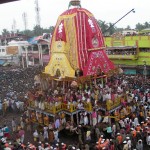 Puri represents one of the four peethas established by Sankaracharya, the other four being Sringeri in southIndia, Dwarka in Saurashtra, and Badrinath in theHimalayas. Ramananda of the 14th century – a follower of the Sri Vaishnava religious leader Ramanuja, is also associated with this temple.Chaitanya of the 15th – 16th centuries popularized the worship of Jagannath.
Puri represents one of the four peethas established by Sankaracharya, the other four being Sringeri in southIndia, Dwarka in Saurashtra, and Badrinath in theHimalayas. Ramananda of the 14th century – a follower of the Sri Vaishnava religious leader Ramanuja, is also associated with this temple.Chaitanya of the 15th – 16th centuries popularized the worship of Jagannath.
How Rath Yatra Festival is celebrated
Rath Yatra or chariot festival is a festival of Hindus, celebrated on the 2nd day of Shukla Paksha (waxing cycle of moon) in the month of Asadh which is the 3rd month of the lunar calendar followed in certain parts of India. The Jagannath temple in Puri is the main epicenter of this festival. Jagannath Rath Yatra festival commemorates the visit of lord Jagannath along with his siblings to the templeof Queen Gundicha. On their way they stop at their maternal aunt’s place called the mausima temple for a meal of sweet pan cakes which is believed to be the favorite of lord Jagannath.
Lord Jagannath is popularly known as lordKrishna amongst the Hindu devotees. Jagannath temple in Puri is among the four most significant shrines of the Hindus from all over the world and is known as ‘Yamanika Tirtha’ as the power of ‘Yama’ the god of death amongst Hindus is believed to have been nullified in Puri because of the presence of Lord Jagannath who is believed to be residing in the historical Jagannath temple of Puri with his siblings lord Balbhadra and deity Shubhadra. The idols of these deities are taken in three enormously decorated chariots to the abode of queen Gundicha.
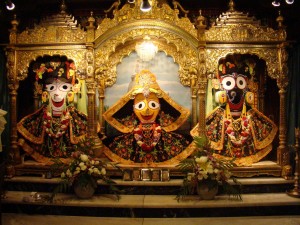 The festival begins with the Ratha Prathistha or invoking ceremony in the morning, but the Ratha Tana or chariot pulling is the most exciting part of the festival, which begins in the late afternoon when the chariots of Jagannath, Balabhadra and Subhdra start rolling. Each of these carriages have different specifications: The chariot of Lord Jagannath is calledNandighosa, has 18 wheels and is 23 cubits high; the chariot of Balabhadra, called Taladhvajahas 16 wheels and is 22 cubits high; Devadalana, the chariot of Subhadra has 14 wheels and is 21 cubits high.
The festival begins with the Ratha Prathistha or invoking ceremony in the morning, but the Ratha Tana or chariot pulling is the most exciting part of the festival, which begins in the late afternoon when the chariots of Jagannath, Balabhadra and Subhdra start rolling. Each of these carriages have different specifications: The chariot of Lord Jagannath is calledNandighosa, has 18 wheels and is 23 cubits high; the chariot of Balabhadra, called Taladhvajahas 16 wheels and is 22 cubits high; Devadalana, the chariot of Subhadra has 14 wheels and is 21 cubits high.
Every year these wooden chariots are constructed a new in accordance with religious specifications. The idols of these three deities are also made up of wood and they are religiously replaced by new ones every after 12 years. After a nine-day vacation of the deities at the country temple amidst festivities, the heavenly summer vacation gets over and the three return to the citytempleofLord Jagannath.
Places to Visit near Puri
Beach of Puri
Puri beach is famous for its golden sands, soothing sun-bath and the colourful sunrise and sunsetOverlooking the Bay of Bengal. There you can bathe and laze or enjoy seeing, the local fishermen plying their catamarans and sail boats. This beautiful beach is quite long and wide extending for miles.
Shree Lokanath
Temple Dedicated to Lord Shiva is said to be the place where Lord Shiva hid himself from Shani, under a pond. The Shiva Linga here is partially submerged and the pond is teeming with fish. Priests here tend to be very strict so do maintain etiquette.
Sun Temple of Konark
Constructed from oxidizing and weathered ferruginous sandstone. The temple is one of the most well renowned temples in India and a UNESCO World Heritage Site.
Chandrabhaga: The famous Sea Beach known for the sacred Dip on Magha Saptami.
Chilika Lake: The biggest inland lake in India is well known for the most migrating birds, even few comes from Siberia for their winter rest.
Satapada (Satapara): One of the most popular tourist places of Orissa, Where Dolphins and the scenic Sea Mouth attract large number of tourists every year. Satapada also provides the opportunity for viewing a memorable sunrise and sunset.
Pipili: The famous place for unique Appliqué Work.
Raghurajpur: Famous for Appliqué and Patta Chitra (Palm-Leaf Arts).
The Puri-Konark Marine Drive: This road was recently renovated and hence is in superb condition. Is peppered with deserted beaches and many rivers fall into the sea in places visible, if not accessible, from the road. Some beaches are said to have quicksand. Along the way there is a temple Ramchandi which is a popular picnic spot amongst the locals as non-veg. is allowed in the temple.
There are so many other places to visit like:
- Sunara Gaurang Temple
- Bedi Hanuman Temple
- Chakra Tirtha Temple
- Mausima Temple
- Shree Gundicha Temple Destination of Rath Yatra
- Shankaracharya’s GOBARDHAN Pitha
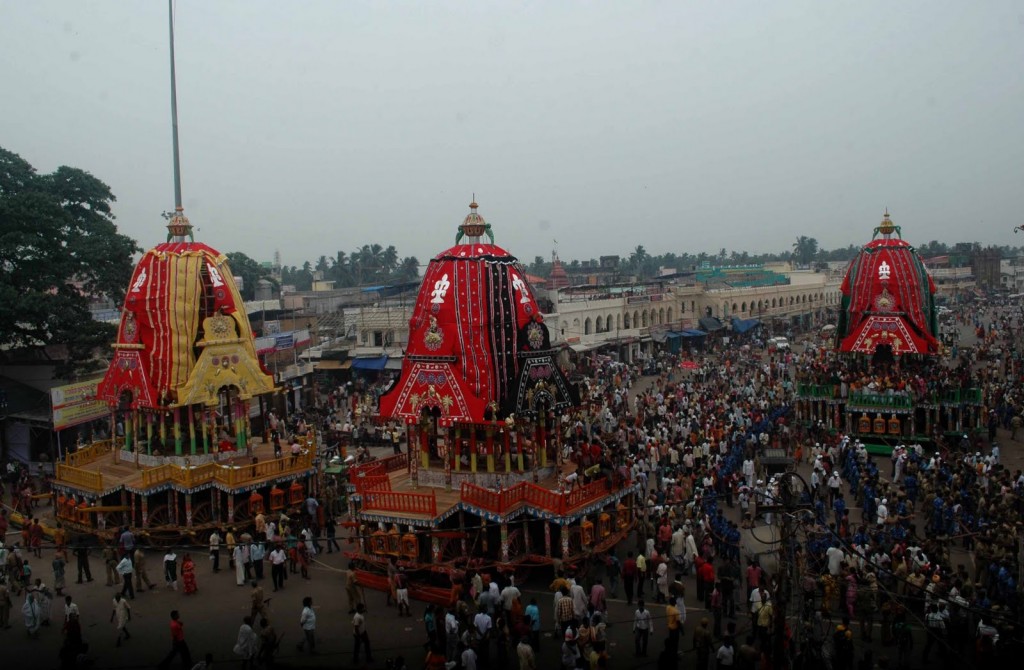
Submit your review | |
